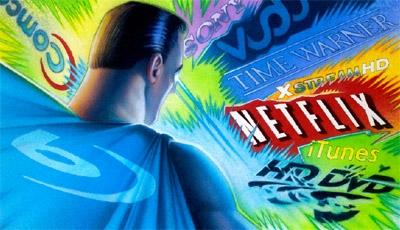To the Victor Go the Spoils?

After 4 years of testy hostility and 2 more years of bare-knuckled conflict, the war between HD DVD and Blu-ray Disc came to an abrupt end. Hours before the start of the Consumer Electronics Show in January, Warner Bros. announced that it was abandoning HD DVD. Warner is the largest studio in the home-entertainment market, and its decision tipped the scales. A few weeks later, Toshiba announced that it would no longer make or market HD DVD players. With shocking immediacy, the guns fell silent.
Blu-ray might have marched down Broadway, hugging and kissing all the pretty girls. But the response was curiously muted. Sony, Blu-ray's mentor, didn't even hoist a "Mission Accomplished" banner. Modesty befitting a victor? Perhaps. Or maybe Blu-ray knew that the worst was yet to come.
When VHS beat Betamax, it absolutely owned the field of battle. VHS was the one and only, and customers couldn't wait to get it. Same thing when DVD, in turn, punched out VHS. But Blu-ray faces a messy postwar period. More accurately, it faces another war - in fact, a couple of them.
For starters, there's little evidence that people are clamoring for Blu-ray. If PS3 sales are subtracted, there's barely a pulse for Blu-ray players. Sure, some of that sluggishness is due to format-war uncertainty; no one wants to end up with the wrong technology. (To the 1 million owners of terminal HD DVD players, my deepest sympathies.)
Also, discs in general might be in decline. Sales of DVDs have accounted for 60% of studio revenues in recent years. But domestic sales fell 3.2% last year, with more falloff predicted. The average price of a DVD was $15 last year, compared with $22 in 2000 - that's not a healthy market. Also, people are generally happy with upconverting DVD players and might not feel compelled to upgrade to a new disc format.
The A/V business used to be driven by evolutionary jumps in performance. Then a funny thing happened: Performance got so good that many people regarded it as being good enough. DVD-Audio and SACD were leaps and bounds better than CD, and no one cared. Meanwhile, convenience factors like portability and huge storage capacity outweighed concerns about sound quality, which led to iPods and other MP3 players taking over the market. Suddenly, not only were DVD-A and SACD in trouble - so was the CD. People had discovered downloading.
That, in fact, is the loaded barrel aimed squarely at Blu-ray's shiny play-back plastic. Online music is already prolific, and movies are right behind. Apple's iTunes offers 500 movie titles. Outfits like Netflix (with LG), XStream- HD, and Vudu are joining in. And Time Warner Cable and Comcast are complicit with faster broadband hookups. Downloading HD movies takes tons of bandwidth, but once the pipes are big enough, HD downloading will be huge.
Blu-ray also faces the marketplace complexity of unprecedented media diversity. For example, when Toshiba threw in the HD DVD towel, it also made a (widely overlooked) announcement that it was fast-forwarding to its next offensive: aggressive development of NAND flash memory and small hard disks, both of which are potential HD media. Further complicating Blu-ray's future, some DVD movies are being packaged with a disc that holds a duplicate digital file that can be viewed on a computer or moved to a portable player. In another twist, Sony is hedging its bets, releasing niche titles on HP's manufactured-on-demand disc service.
Blu-ray is a fabulous format, with built-in technological opportunities to expand its scope. I sincerely hope that it succeeds. But soon, Blu-ray might feel nostalgic for the days when its only nemesis was its evil high-def twin. That's because it will be combating new delivery infrastructures and technologies, springing up like warriors sown from dragon's teeth. The sibling rivalry is over. Now, it's total war.
- Log in or register to post comments























































